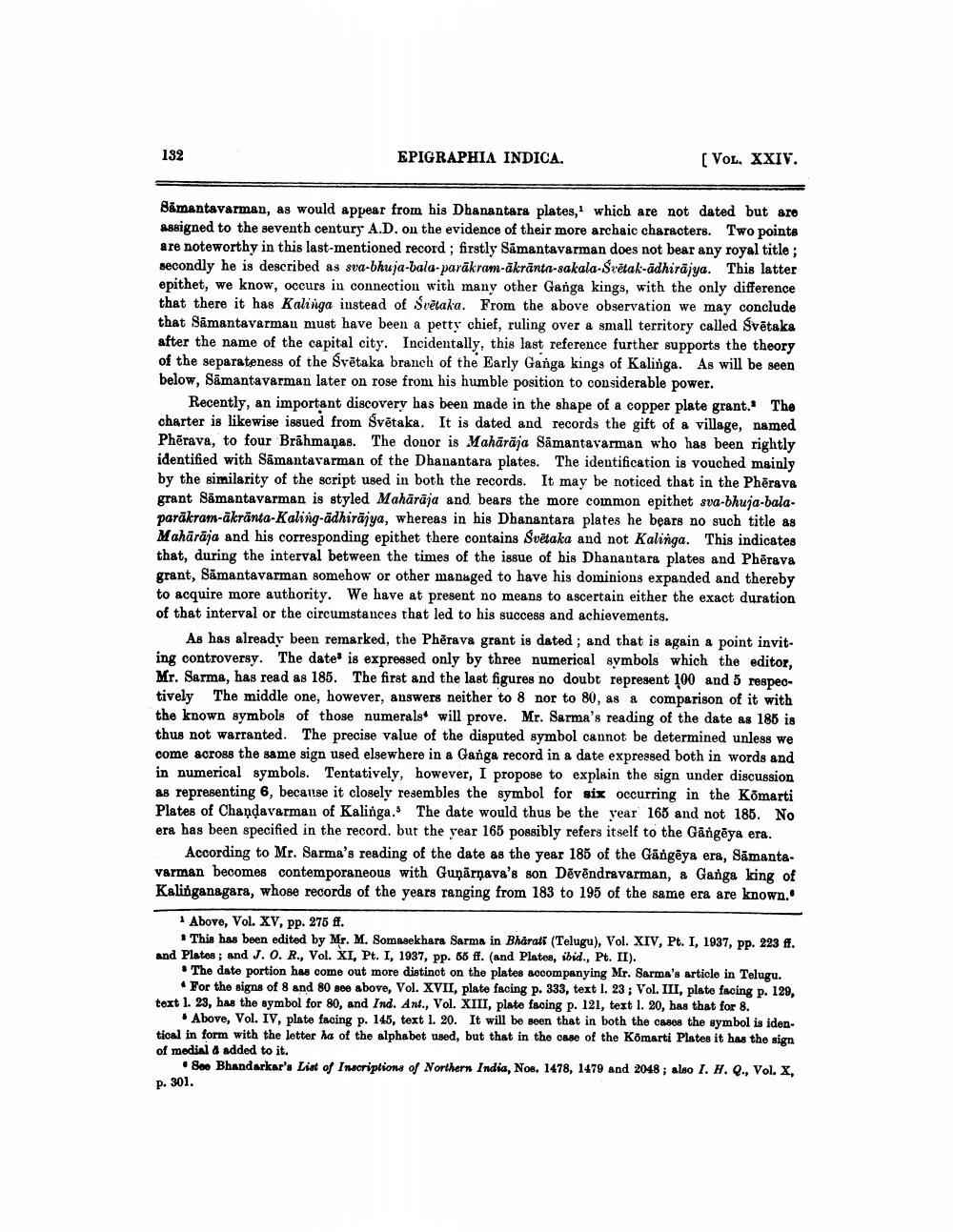________________
132
EPIGRAPHIA INDICA.
(VOL. XXIV.
Såmantavarman, as would appear from his Dhanantara plates, which are not dated but sro assigned to the seventh century A.D. on the evidence of their more archaic characters. Two points are noteworthy in this last-mentioned record ; firstly Samantavarman does not bear any royal title ; secondly he is described as sva-bhuja-bala-parākram-ākrānta-sakala-Śrētak-adhirajya. This latter epithet, we know, occurs in connection with many other Ganga kings, with the only difference that there it has Kalinga instead of Svētaka. From the above observation we may conclude that Samantavarman must have been a petty chief, ruling over a small territory called Svētaka after the name of the capital city. Incidentally, this last reference further supports the theory of the separateness of the Svētaka branch of the Early Ganga kings of Kalinga. As will be seen below, Samantavarman later on rose from his humble position to considerable power.
Recently, an important discovery has been made in the shape of a copper plate grant. The charter is likewise issued from Svētaka. It is dated and records the gift of a village, named Phērava, to four Brāhmaṇas. The donor is Mahārāja Sāmantavarman who has been rightly identified with Samantavarman of the Dhanantara plates. The identification is vouched mainly by the similarity of the script used in both the records. It may be noticed that in the Phērava grant Samantavarman is styled Mahārāja and bears the more common epithet sva-bhuja-balaparākram-ākrānta-Kaling-ādhirājya, whereas in his Dhanantara plates he bears no such title as Mahārāja and his corresponding epithet there contains Svētaka and not Kalinga. This indicates that, during the interval between the times of the issue of his Dhanantara plates and Phērava grant, Sämantavarman somehow or other managed to have his dominions expanded and thereby to acquire more authority. We have at present no means to ascertain either the exact duration of that interval or the circumstances that led to his success and achievements.
As has already been remarked, the Phêrava grant is dated ; and that is again a point inviting controversy. The dateis expressed only by three numerical symbols which the editor, Mr. Sarma, has read as 185. The first and the last figures no doubt represent 100 and 5 respectively The middle one, however, answers neither to 8 nor to 80, as a comparison of it with the known symbols of those numerals will prove. Mr. Sarma's reading of the date as 185 is thus not warranted. The precise value of the disputed symbol cannot be determined unless we come across the same sign used elsewhere in a Ganga record in a date expressed both in words and in numerical symbols. Tentatively, however, I propose to explain the sign under discussion as representing 6, because it closely resembles the symbol for six occurring in the Komarti Plates of Chandavarman of Kalinga. The date would thus be the year 165 and not 185. No era has been specified in the record, but the year 165 possibly refers itself to the Gangěya era.
According to Mr. Sarma's reading of the date as the year 185 of the Gangēya era, Samantavarman becomes contemporaneous with Gunārņava's son Dēvēndravarman, a Ganga king of Kalinganagara, whose records of the years ranging from 183 to 195 of the same era are known.
1 Above, Vol. XV, pp. 275 ff.
1 This has been edited by Mr. M. Somasekhara Sarma in Bharati (Telugu), Vol. XIV, Pt. I, 1937, pp. 223 f. and Plates; and J. O. R., Vol. XI, Pt. I, 1937, pp. 55 ff. (and Plates, ibid., Pt. II).
* The date portion has come out more distinct on the plates accompanying Mr. Sarma's article in Telugu.
For the signs of 8 and 80 see above, Vol. XVII, plate facing p. 333, text I. 23; Vol. III, plate facing p. 129, text l. 23, has the symbol for 80, and Ind. Ant., Vol. XIII, plate facing p. 121, test 1. 20, has that for 8.
Above, Vol. IV, plate facing p. 145, text I. 20. It will be seen that in both the cases the symbol is iden. tical in form with the letter ha of the alphabet used, but that in the case of the Kömarti Plates it has the sign of medial & added to it.
.See Bhandarkar's List of Inscriptions of Northern India, Nos. 1478, 1479 and 2048 ; also I. H. Q., Vol. X, p. 301.




